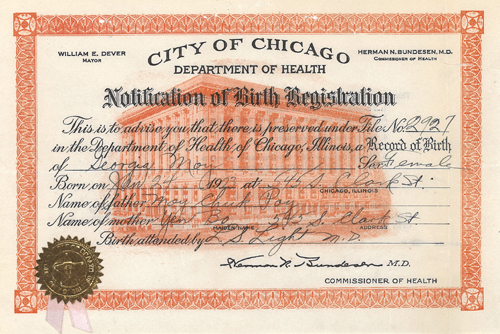
Back row: Tai You (servant girl), Moy Mee Ting (applicant)
Front Row: Moy Ngoon See, Woo Shee (mother), Moy Fang Dhl, Moy Mon Dle
Moy Mee Ting 梅美清 (Georgia Moy) and her bother Moy Fang Dhl 梅宏資 (Stanley Moy) were admitted to the U. S. at the Port of Seattle on 3 September 1937 as native born U. S. citizens. Georgia was 14 years old and Stanley was a year younger. They were joining their father, Moy Chuck Poy in Chicago, Illinois. Their native dialect was See Yip Sun Ning.

The Moy family went to Sai How Gow Dee village, China in 1927 so the children could study Chinese. The children Georgia, Stanley, and Philip (Moy Mon Dle) were all born in Chicago. Their mother Woo Shee (maiden name: Woo Yin Po) stayed in China and their father returned to the U. S. about 1929. The children and their mother moved to Ng Gong market near Gow Dee village in about 1932 because there were many floods in their former village.
Moy Mee Ting’s paternal grandfather, Moy Fang Chung (marriage name: Moy Dip Nai), was living in Detroit in 1937.
Moy Mee Ting testified that Sai How Gow Dee village had over 100 houses and she attended the Sai How School. There were over 100 students and including about thirty or forty girls. There were no women teachers. In her interview she was asked about size of the village, the number of stores, the number of stories of various buildings, who lived where, where they got their household water, how their house was lighted, where everyone slept, the number of beds, who cut her hair, why her mother had a servant girl, and many more questions.
When they moved to Ng Gong market the children attended the gospel mission school called Jing Ock. They had women teachers at this school. Chairman Inspector J. H. Gee asked Mee Ting several questions about where her mother got the money to support them after her father returned to the U.S. and where she got the white gold wrist watch she was wearing. She replied that her father had been sending her mother money and her mother gave her the watch before she left for the U.S.
Their mother accompanied them to Hong Kong. They took a boat from Ng Gong market to Ow San market, a train to Bok Gai and a steamer to Hong Kong. Their mother said goodbye onboard and a man named Chin Deung Fun oversaw them on the trip to the U.S.
Mee Ting correctly identified photos of her father, Moy Poy, (SF file 20173/13-16) (Seattle file 10724/12-10) and her mother, Wu [Woo] Yin Po (SF file 20173/17-3) and her brothers. Six pages of testimony by her brother, Moy Fang Dhl, is included in her file. The next day Moy Mee Ting was recalled to the hearing. Three more pages of testimony are included in the file. The interviewers compared her answers to her brother’s and asked about discrepancies and included more in-depth questions. Mee Ting and Fang Dhl were both admonished for saying that they had a brother named Ngoon Jee. They admitted that there was no such brother and were cautioned not to say he was a brother. They provided a group photo of the family which did not include the “extra brother.”
The Immigration committee reviewed the parents’ files from 1917 and 1921 and the family’s files from when they left the country in 1927 and voluminous current testimony and unanimously approved the admittance of Moy Mee Ting and Moy Fang Dhl.
